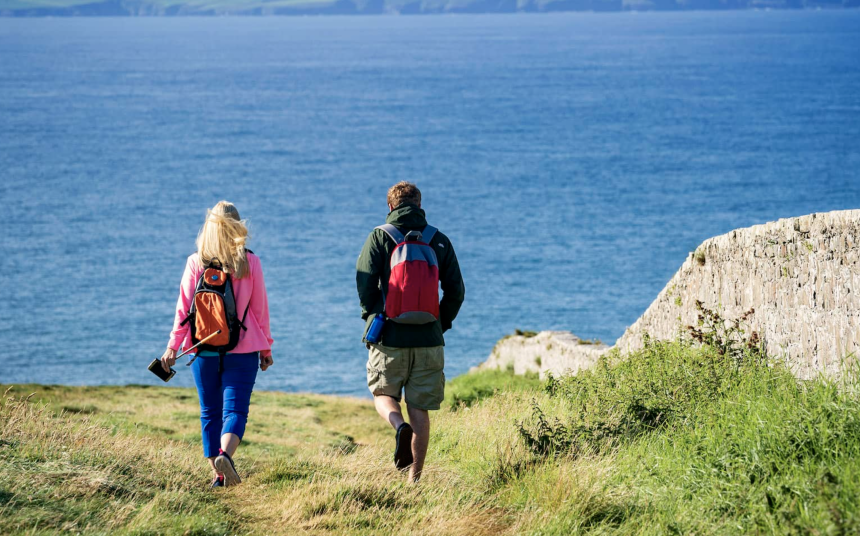Ireland offers stunning landscapes and unsurpassed scenic beauty, making the island the perfect paradise for those with a love of hiking or walking. From relaxing scenery to soaking up history and culture, there are so many advantages to walking in Ireland. It all starts with carefully planning your outdoor adventure and gearing up with the right accessories!
Planning A Coastal Stroll
Ireland has a varying landscape that’s home to a terrain of rich peaks and valleys as well as bogs, canal banks, and beaches. Given the fact that this nation is an island, it lends itself to the opportunity to plan for many coastal walks. To serve as a starting point, many may wish to start their walk along the Causeway Coast or the Wild Atlantic Way. Both of these routes are ideal as they closely hug the curves of the existing coastline and feature a fairly uneven mountainous terrain. This is an ideal kick-off point for hikers hoping for something unique and adventurous.
The Wild Atlantic Way has some stunning places that come highly recommended as stopping points, such as:
- Dingle
- Beara
- The Inishowen Peninsulas
- Achill Island
- County Mayo
Much of what walkers will experience is a mix of pastoral farmlands and deep glens that take them far away from their worldly troubles. Northern Ireland is home to the Glens of Antrim and the Causeway Coast Walking Route. Antrim has some of the most unique natural beauty known on the island for its nine glacial glens that lend the area an almost otherworldly splash of green colouring. If a mythically inclined walk isn’t entirely your cup of tea, The Gobbins Cliff Path is able to carry you to the exact point where the land meets the sea featuring a lookout bridge and basalt cliffs.
As Ireland has an ancient past, it simply wouldn’t do it justice to ignore the Copper Coast Geopark with its jaw-dropping shoreline home to sea stacks, cliffs, and coves. The area got its name from the once flourishing mining industry that allowed the region to prosper. The Kerry Way and Dingle peninsula walking tour is another spectacular walk in Ireland with breathtaking views.
Going Off-The-Beaten-Path
If you prefer something quirky and informal, bog walks across Ireland may whet your appetite. Offaly, Tipperary, Connemara, and Laois offer a bountiful muddy path that certainly is unique! Of course, for a cleaner cut path and a more straightforward walk, there are a large number of canals that are perfect for strolling along.
If you have the stamina to go for an uphill climb, get the ultimate workout by following the path of the Mourne Wall. For mountainous terrains and landscapes in the same region, Kerry Ways and The Wicklow both have the occasional calmer stretches of path. If a strenuous hike is not necessarily what you seek, Slieve Blooms can provide visual reprieve with a less taxing terrain. Lastly, brave souls that wish to take a short yet physically demanding hike may wish to consider the Comeragh Mountains in County Waterford.
5 Ways To Prepare For Walking In Ireland
Though Ireland is known for its turbulent and ever-changing weather, it rarely ever gets very cold— even during the wintertime! In fact, what makes Ireland such a wonderful tourist destination is that there’s almost always an opportunity for a hike or a stroll, regardless of where you stay.
Whether you choose to walk the river banks or through the stunning green glens, there are a few things you should keep in mind to prepare for your walk:
1. Keep Your Bags Packed
Even if you don’t think your walking tour will take you long, it’s better to keep your bags packed. This way, you can ensure that your belongings are easily transported to you in case you have a change of plans.
2. Try A Walking Festival
Walking festivals are a popular pastime in Ireland because the Irish love to walk! This is also a great time to get out there and meet new friends because you will have the opportunity to interact with others during your walk.
3. Plan The Right Walking Length
There are different walking lengths that you can prepare for. For example, a 1-5 hour walk is considered short, meanwhile, an 8-30 km walk is seen as a medium length stroll. Of course, it’s also possible to plan for long-distance walks that last anywhere from 35-1,000 km.
4. Bring The Right Gear!
It’s important to invest some funding into acquiring the right walking gear. Sun lotion and rain gear are both necessities due to the changeable weather.
5. Walking Paths Are Marked
The most helpful part of walking in Ireland is that many of the ways have waymarked paths that are circular or linear but also feature marked out sections. This enables you to take things slow and to tackle different paths at different times. In many instances, the terrain is also marked to help people of all fitness levels choose accordingly.
From getting fit to simply enjoying the great outdoors, strolling across Ireland is both a great workout and a unique adventure!
Lynn Martelli is an editor at Readability. She received her MFA in Creative Writing from Antioch University and has worked as an editor for over 10 years. Lynn has edited a wide variety of books, including fiction, non-fiction, memoirs, and more. In her free time, Lynn enjoys reading, writing, and spending time with her family and friends.















